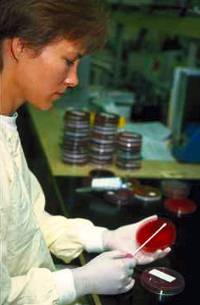31 August 1998
Bacterial Defences Uncovered

Researchers at the Children's Hospital Medical Center of Cincinnati have discovered that flavohemoglobin, a protein in bacteria, protects the bacteria from nitric oxide (NO), a toxic chemical secreted by the immune system to help kill disease-causing micro-organisms. The protein, which the researchers have re-named nitric oxide dioxygenase (NOD), detoxifies the NO and allows the bacteria to survive. Without the protection NOD affords, bacteria would be unable to infect the host.
Interestingly, NOD is an old protein, perhaps billions of years old, originating around the time oxygen appeared in the earth's atmosphere. "It's actually the forerunner of hemoglobin - a protein in red blood cells that carries oxygen," says Dr. Salzman, co-discoverer of the mechanism. "It's abundant and present throughout the animal kingdom for transporting oxygen in the blood.
It's been known for many years that there is a form of hemoglobin in bacteria, but its function was entirely unknown. It surely wasn't to carry oxygen. Now we've discovered what we believe is the fundamental purpose of this protein - to protect organisms against nitric oxide. So we are now providing an understanding of the evolutionary basis of hemoglobin and the original function of the hemoglobin family - to detoxify nitric oxide."
The discovery could herald the development of new antibiotics which disable the NOD defensive mechanism. "Bacteria vary enormously in their ability to defend themselves against nitric oxide," says Dr. Salzman. "But if you remove this protein from bacteria, you can kill them with almost nothing. They're exquisitely sensitive to nitric oxide."
So far, the researchers have studied only the most common bacteria at the basic level. But because NOD is broadly represented in different bacteria, they have no reason to believe this mechanism is unique to any particular strain.
